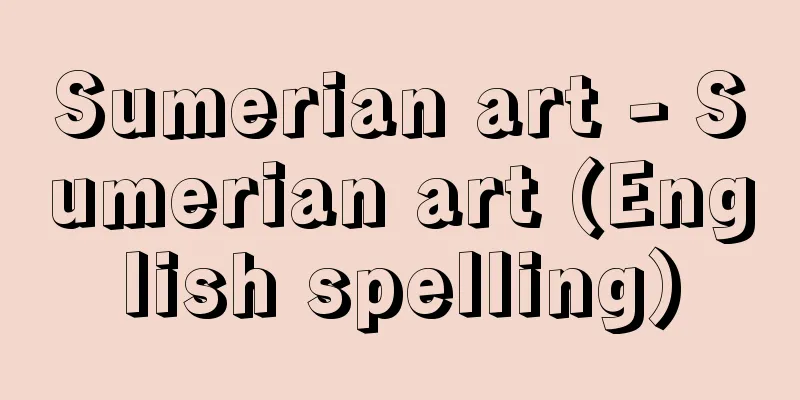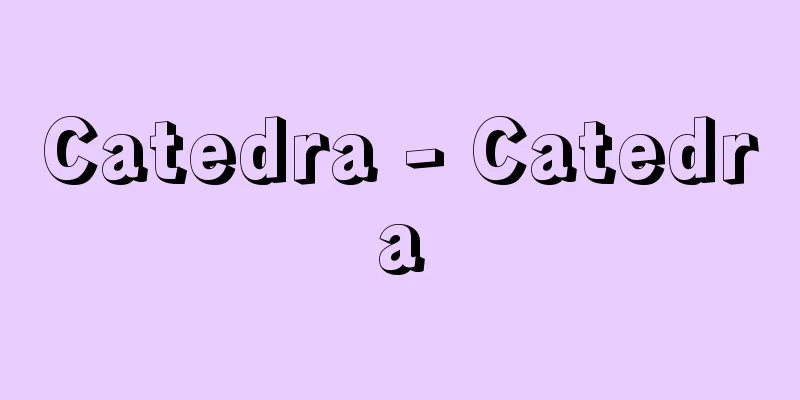Sumerian art - Sumerian art (English spelling)

|
The art of the Sumerians, who ruled southern Mesopotamia from around 3000 to 2000 BC. It is divided into three periods: the Early Dynastic Period, the Akkadian Period (→ Sargon), and the Third Dynasty of Ur. In the first period, cities such as Uruk, Ur, Eridu, Lagash, Nippur, and Kish were built, and unprecedented progress was made in architecture, painting, sculpture, and crafts. Sculptures include many small statues excavated from Tell Asmar, Mari, Ashur, Al, and Ubaid. The mosaic panel known as the "Standard of Ur" excavated from the Royal Tomb of Ur is a representative example of early Sumerian painting. The mosaic inlaid on the body of a harp excavated from the same site depicts animal combat scenes and the legend of Gilgamesh, demonstrating their skill in depicting animals. Other works that show a high level of metal casting technology include a cast bronze bull and a frieze depicting the lion-headed bird Imdogud capturing two deer. The pinnacle of metalworking techniques was also seen in precious metal accessories, everyday tableware, weapons, and other items. In the Akkadian period, as seen in the reliefs of the Victory Stele of Naram-Sin excavated at Tell Brak (Louvre Museum), the freedom of expression and the beautiful capture of the moment of victory led to an increase in artistic quality. The bronze head of Sargon the Great (Iraq Museum) is a representative example, and although somewhat stylized, it shows realistic and powerful expression. It can be said to express the ethnic differences between the Sumerians and the Hamitics. In the late Sumerian period, the numerous diorite statues of Gudea, King Gudea of Lagash, who resisted the rule of the foreign Gutians, are representative examples, reviving the rigid, ancient Sumerian expression. Source: Encyclopaedia Britannica Concise Encyclopedia About Encyclopaedia Britannica Concise Encyclopedia Information |
|
前 3000年頃から前 2000年頃まで,主として南メソポタミアを支配したシュメール人の美術。初期王朝時代,アッカド時代 (→サルゴン ) ,ウル第3王朝時代の3期に分ける。第1期はウルク,ウル,エリドゥ,ラガシュ,ニップール,キシュなどの都市を建設し,建築,絵画,彫刻,工芸など各分野に空前の進歩をみせた。彫刻にはテル・アスマル,マリ,アッシュール,アル,ウバイドなどから出土した多数の小像などがある。ウル王墓出土の『ウルのスタンダード』と呼ばれるモザイク板はシュメール前期絵画の代表例。同所出土の竪琴の胴に象眼されたモザイク画には動物格闘文やギルガメシュ伝説などが描かれ,動物表現に優れていたことを示している。ほかに鋳銅雄牛像や獅子頭の鳥イムドグドが2頭のシカを捕えている図のフリーズなど,鋳金技術に高い水準をみせている。また貴金属装身具,日常食器,武器などにも金工技術の粋をみせている。アッカド期に入るとテル・ブラク出土の『ナラム=シンの戦勝碑』 (ルーブル美術館) の浮彫にみられるように,表現が自由で,勝利の瞬間をみごとにとらえ,芸術性が増す。『サルゴン大王像』 (イラク博物館) の青銅頭部像はその代表例で,やや様式化されたなかにも写実的な力強い表現がみられる。シュメール人とハム人との民族的相違を表出しているといえよう。シュメール末期は異民族グティ人の支配に抵抗して立ったラガシュのグデア王の閃緑岩による多数の『グデア像』がその代表例で,古式の硬いシュメール式表現を復活させた。
出典 ブリタニカ国際大百科事典 小項目事典ブリタニカ国際大百科事典 小項目事典について 情報 |
>>: Sumerians - Sumer (English spelling)
Recommend
passionflower
...Propagation is by cuttings. More than 400 spec...
Defense - Defense
Herbal medicine Use for Herbal medicine One of th...
Hydrogen Bomb - Suisoba Kudan
A nuclear weapon that produces a greater explosive...
American Cypress - American Cypress
...Because its wood resembles that of cypress, it...
Mardan (English spelling)
A city in the central part of the North-West Front...
La bohème
Puccini's four-act opera, composed to a libret...
Manichaeism - Manichaeism
It is a universal religion founded by Mani in the...
Ono Yoshimu
...Yamaha Torakusu (1851-1916) then established N...
Dajokan - Dajokan
(1) One of the two offices at the center of the Ri...
Akaigawa [Village] - Akaigawa
A village in Yoichi District, Hokkaido. With an in...
Cooke, S.
...As a slang word, "soul" intuitively ...
Fading red - Arazome
A color name. It can also be read as "taikou....
Sphenoid bone
…the upper half of the occipital scale sometimes ...
Smārta (English spelling) Smarta
...The other is the Bāmatī sect, based on the Bām...
Park Kyung-ri
A Korean female writer. She is the mother-in-law o...

![Tigris [river] - Tigris](/upload/images/67cc3fb24039b.webp)







